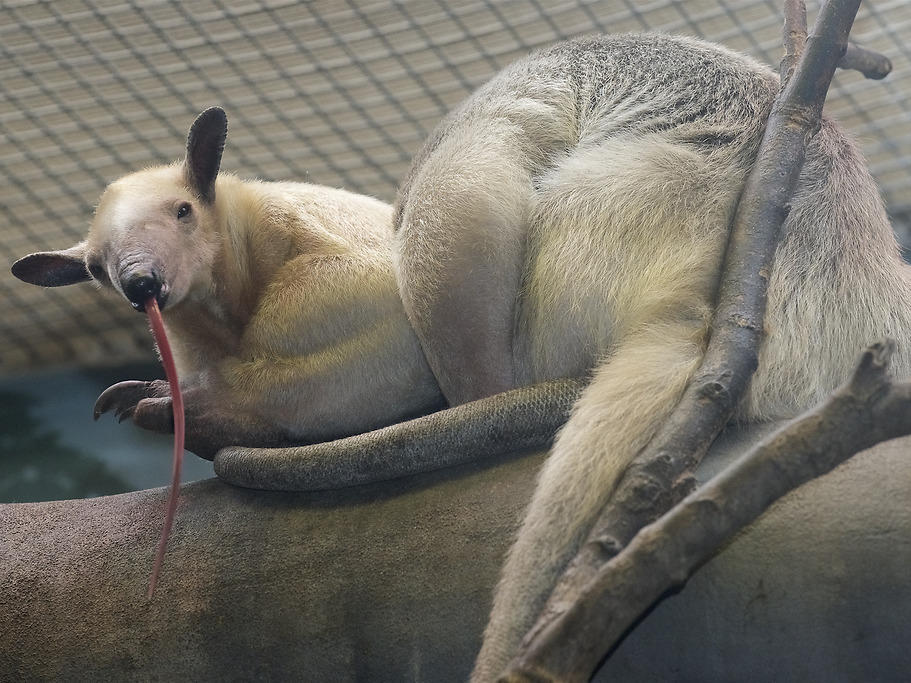Section Branding
Header Content
Manny loves Cayenne. Plus, 5 facts about queer animals for Valentine's Day
Primary Content
You may have heard about a gay penguin couple at the Central Park Zoo. The story of two male penguins who parented a baby penguin became an award-winning – and often banned – children's book called "And Tango Makes Three."
In a Valentine's Day exclusive report, NPR has learned there is currently a gay anteater couple at Smithsonian's National Zoo and Conservation Biology Institute in Washington D.C.
Manny and Cayenne were paired together to breed by zookeepers a few years ago. "They honestly were fast friends," says Kenton Kerns, assistant curator of the Small Mammal House. "We saw them rolling around and we thought that was really encouraging – great breeding behavior."
But two years passed, and Cayenne hadn't gotten pregnant, so the zoo brought in a reproductive specialist. "We put Cayenne on the table and we were about to start her reproductive exam and the reproductive scientist said, 'Well, I think the issue is that these are not ovaries, they're testes,'" Kerns says. Apparently, it's not easy for the casual observer to tell male and female anteaters apart. Still, he admits, "it seems super obvious, looking back on it."
Manny and Cayenne have continued their bond. "It just turned out to be a bromance for the ages," Kerns says.
Gay penguin and anteater couples in zoos are just the tip of the proverbial iceberg when it comes to queerness in the animal world – it's been documented in hundreds of species.
NPR spoke with wildlife ecologist Christine Wilkinson of the "Queer is Natural" TikTok series for Valentine's Day. Here are some of her favorite facts about queer animals.
This conversation has been edited for length and clarity.
Interview Highlights
1. Banana slugs are hermaphrodites
There are a ton of animals that have both male and female genitalia. Banana slugs are simultaneous hermaphrodites – they can inseminate each other's eggs at the same time. If they can't find a mate, they can also undergo parthenogenesis, where they clone themselves — no sperm needed.
2. There's an all-female lizard species
In the New Mexico whiptail lizard species, there are no males. The female lizards reproduce through parthenogenesis.
These lizards are special for another reason as well: Instead of just cloning themselves, they first produce twice the number of chromosomes. These chromosomes then get recombined to form genetically diverse offspring.
The lizards still sometimes mount one another – and the lizard that's on the bottom ends up producing bigger eggs than the lizard that's on the top. So it seems like there is some evidence of tops and bottoms.
3. Clownfish switch genders
Different fish species, including clownfish, change sex once they get big enough. This allows them to avoid conflict over who has access to the female.
The largest fish within a clownfish colony is the female and then the next largest fish is a male – often the one mating with the female. The colony follows a size-based queuing process. Once a clownfish dies, the others move up the ladder and change sex accordingly. So Finding Nemo would've been more accurate if Marlin, Nemo's dad, had become female.
4. Some deer are nonbinary
In the mammal world, deer have a third gender called velvet horns — males that never shed the velvet on their horns even after they fully mature. Their testicles never fully drop.
But there have been cases of velvethorns adopting fawns that have been orphaned and helping to raise them. The velvethorns help out the group and play a similar male social role regardless of whether they're able to mate or procreate.
5. Bonobos make love, not war
As a social species, our survival relies on us being able to get along with one another. Same-sex sexual behaviors and pair bonding among the same sex is thought to be another way of strengthening these bonds and assuring that we can protect each other, take care of each other and help each other forage.
So think about an animal like a bonobo. One of our closest relatives, a primate species – they have so much sex. It's thought to be like, 'Hey, instead of fighting over these resources, let's just have sex with one another, feel good about it and share.' And that's really worked out for them. There's quite a lot of sex for pleasure out there in the animal kingdom.
Questions, comments or thoughts on queer animal love? Email us at shortwave@npr.org and we might feature it on a future episode!
Listen to Short Wave on Spotify, Apple Podcasts and Google Podcasts.
Listen to every episode of Short Wave sponsor-free and support our work at NPR by signing up for Short Wave+ at plus.npr.org/shortwave.
This episode was produced by Margaret Cirino and edited by Rebecca Ramirez. Brit Hanson checked the facts. Becky Brown was the audio engineer. Special thanks to Robert Rodriguez.



